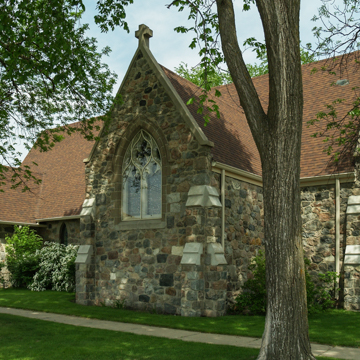Grace Episcopal Church is one of a number of North Dakota churches modeled after Christ Church in Medway, Massachusetts, through a link with the Reverend B. F. Cooley. There is a considerable difference in appearance between the Medway and Jamestown churches, but much of this may be traced to the intention to build Grace Church in two stages. Features of this church that are typical of Episcopal churches include the side porch, steeply pitched gable roof, pointed-arch openings, asymmetric plan, honest expression of materials, and emphasis on the chancel. The church began as a gable-roofed nave with an offset chancel, south entrance porch, and a vestry on the north. In 1890, a flat-roofed parish hall was added to the rear of the nave. This, like the original building, has fieldstone walls and Gothic Revival detailing, as well as a crenellated parapet. In 1913, the interior was extensively reconfigured in the course of a major addition that doubled the size of the church. While these changes continued the scale, materials, and Gothic Revival motifs of the original, they also reflect a more modern version of the style. In all the construction phases, local split fieldstone, roughly dressed and with thick mortaring, was the primary wall material. Inside, the bow-shaped wooden hammer trusses resting on heavy wood beams are defining features.
You are here
Grace Episcopal Church
If SAH Archipedia has been useful to you, please consider supporting it.
SAH Archipedia tells the story of the United States through its buildings, landscapes, and cities. This freely available resource empowers the public with authoritative knowledge that deepens their understanding and appreciation of the built environment. But the Society of Architectural Historians, which created SAH Archipedia with University of Virginia Press, needs your support to maintain the high-caliber research, writing, photography, cartography, editing, design, and programming that make SAH Archipedia a trusted online resource available to all who value the history of place, heritage tourism, and learning.


